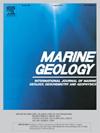帕洛马雷斯大陆坡(地中海西部)海底大规模运动的规模-频率分布
IF 2.6
3区 地球科学
Q2 GEOSCIENCES, MULTIDISCIPLINARY
引用次数: 0
摘要
在这项工作中,对位于地中海西部的帕洛马斯大陆坡超过 3620 平方公里的区域进行了分析,以量化近期大规模运动对该边缘的影响。通过定义几个形态变量,共确定、绘制和描述了 936 个滑坡,这些变量勾勒出滑坡对大陆坡的累积影响,相当于 918 平方公里和 10.34 立方公里的侵蚀沉积物。最小的事件面积为 0.0014 平方公里,最大的事件面积为 32.48 平方公里。当环境较陡峭时,头墙坡度较高的小型疤痕往往占主导地位,主要的大规模运动位于开阔的斜坡和构造高地。然而,变量之间的轻微或无相关性表明,在任何坡度和任何深度都可能出现各种规模的疤痕。与其他被动边缘(如美国大西洋大陆边缘)相比,山体滑坡移动的沉积物数量有限,但与地中海其他地区的小到中等规模的事件特征相当。累积规模分布可以用幂律函数来定义,该函数描述了面积大于 0.7 平方公里的事件,指数为 α = 1.269。这些结果与其他已公布的清单一致,包括陆上案例。根据这一结果,我们可以假定事件的尺度不变特性已经绘制。规模不变特性可以用不同的模型来解释;自组织临界性(SOC)可能是科学界最为推崇的模型,但也有其他模型可供选择。每种模型对任何斜坡的滑坡分布和长期滑坡历史都有重要影响。海底斜坡等其他情况以及更精确的滑坡清单可能有助于建立新的危险评估模型,这些模型考虑了从规模-频率分布得出的比例指数。本文章由计算机程序翻译,如有差异,请以英文原文为准。
Size-frequency distribution of submarine mass movements on the palomares continental slope (W Mediterranean)
In this work, over 3620 km2 from the Palomares continental slope, which is located in the W. Mediterranean Sea, was analysed to quantify the impact of recent mass movements on this margin. A total of 936 landslides were identified, mapped and characterised by defining several morphometric variables that outline the accumulated impact of landslides equivalent to 918 km2 and 10.34 km3 of eroded sediment on the continental slope. The smallest event area was 0.0014 km2, whereas the largest event area was 32.48 km2. Smaller scars with a higher headwall gradient tend to dominate when the environment is steeper, and major mass movements are located on open slopes and structural highs. However, the slight or null correlations between variables indicate that a wide range of sizes may occur on any slope gradient and at any depth.
The Palomares continental slope is intensively affected by mass movements. Compared with other passive margins (e.g., the U.S. Atlantic continental margin), landslides mobilised a limited amount of sediment, although it is comparable to other Mediterranean areas where small- to moderate-sized events are characteristic.
The cumulative size distribution can be defined by a power-law function that describes events larger than 0.7 km2 with an exponent of α = 1.269. These results are consistent with those of other published inventories, including onshore cases. This result allows us to assume that the scale-invariant properties of the events are mapped. Scale-invariant properties can be explained by different models; self-organised criticality (SOC) is probably the most assumed by the scientific community, although alternative models may be nominated. Each model has important implications in terms of the landslide distribution and long-term landslide history of any slope. Alternative scenarios, such as submarine slopes, with more precise landslide inventories may contribute to new hazard assessment models that consider scaling exponents derived from size–frequency distributions.
求助全文
通过发布文献求助,成功后即可免费获取论文全文。
去求助
来源期刊

Marine Geology
地学-地球科学综合
CiteScore
6.10
自引率
6.90%
发文量
175
审稿时长
21.9 weeks
期刊介绍:
Marine Geology is the premier international journal on marine geological processes in the broadest sense. We seek papers that are comprehensive, interdisciplinary and synthetic that will be lasting contributions to the field. Although most papers are based on regional studies, they must demonstrate new findings of international significance. We accept papers on subjects as diverse as seafloor hydrothermal systems, beach dynamics, early diagenesis, microbiological studies in sediments, palaeoclimate studies and geophysical studies of the seabed. We encourage papers that address emerging new fields, for example the influence of anthropogenic processes on coastal/marine geology and coastal/marine geoarchaeology. We insist that the papers are concerned with the marine realm and that they deal with geology: with rocks, sediments, and physical and chemical processes affecting them. Papers should address scientific hypotheses: highly descriptive data compilations or papers that deal only with marine management and risk assessment should be submitted to other journals. Papers on laboratory or modelling studies must demonstrate direct relevance to marine processes or deposits. The primary criteria for acceptance of papers is that the science is of high quality, novel, significant, and of broad international interest.
 求助内容:
求助内容: 应助结果提醒方式:
应助结果提醒方式:


